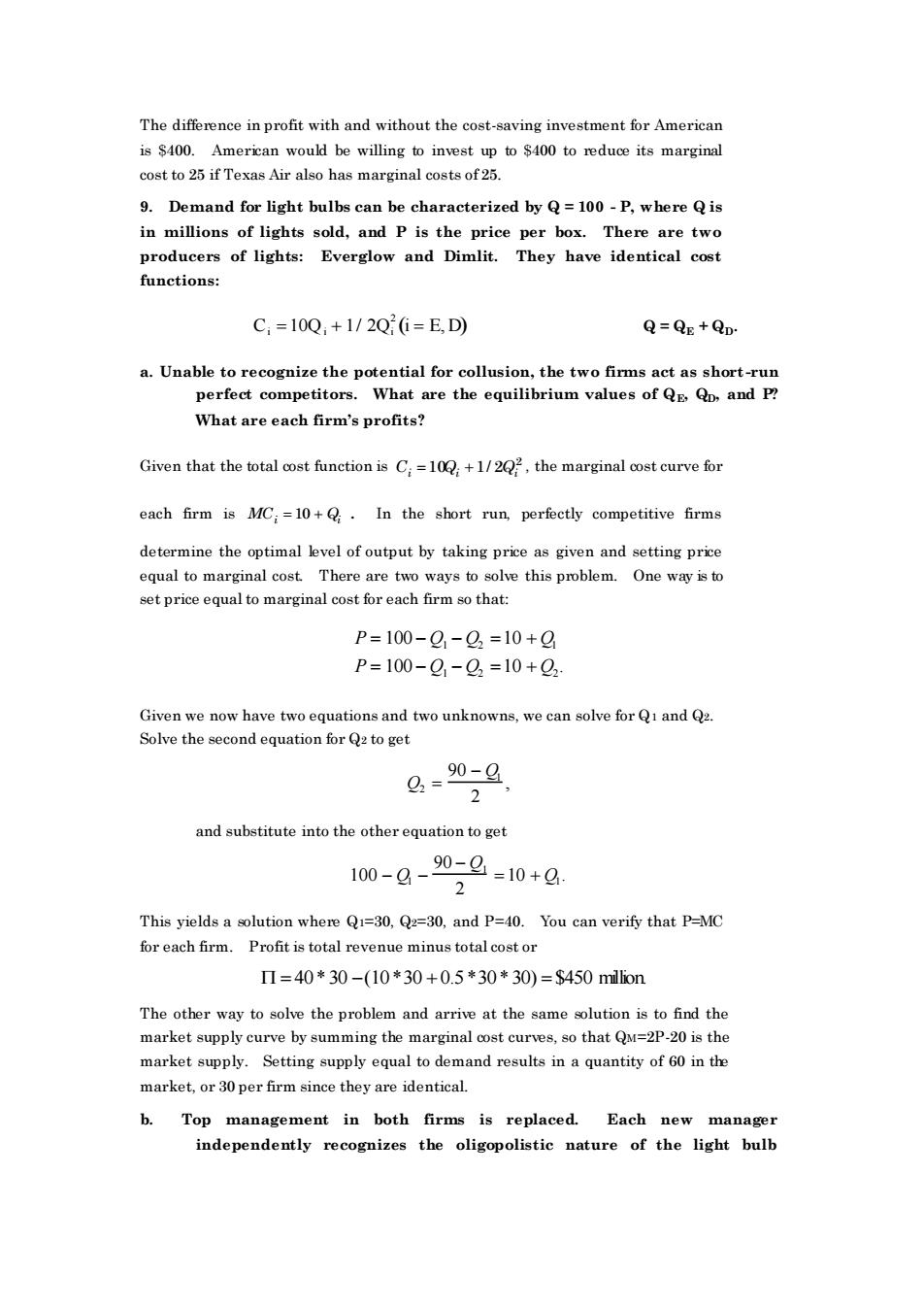正在加载图片...

The difference in profit with and without the cost-saving investment for American is 400. American would be willing to invest to reduce its marginai cost to 25 if Texas Air also has marginal costs of25. 9.Demand for light bulbs can be characterized by Q=100-P,where Qis in millions of lights sold,and P is the price per box.There are two producers of lights:Everglow and Dimlit.They have identical cost functions: C,=10Q,+1/2Q6=E,D) Q=QE+QD a.Unable to recogniz the pot atial for collusio e two firms t as What are each firm's profits? Given that the total cost function is C=10+1/202,the marginal cost curve for each firm is MC:=10+.In the short run.perfoctly competitive firms determine the optimal evel of output by taking price as given and setting price equal to marginal cost.There are two ways to solve this problem.One way is to set price equal to marginal cost for each firm so that: P=100-9-Q2=10+ P=100-9-92=10+22 g-90-g 2 and substitute into the other equation to get 10-g-90,9=10+0 2 This yields a solution where Q1=30,Q2=30,and P=40.You can verify that P=MC oreach firm.Profit is total revenue minus total cos Π=40*30-(10*30+0.5*30*30)=3450lon The other wayto the problem and a at the solution is to find the market upp same y curve by summ ng the marginal cost curves,so that QM=2P-20 is th market supply.Setting supply equal to demand results in a quantity of 60 in the market,or 30 per firm since they are identical. b.Top management in both firms is replaced.Each new manager independently recognizes the oligopolistic nature of the light bulbThe difference in profit with and without the cost-saving investment for American is $400. American would be willing to invest up to $400 to reduce its marginal cost to 25 if Texas Air also has marginal costs of 25. 9. Demand for light bulbs can be characterized by Q = 100 - P, where Q is in millions of lights sold, and P is the price per box. There are two producers of lights: Everglow and Dimlit. They have identical cost functions: Ci =10Qi + 1/ 2Qi 2 (i = E, D) Q = QE + QD. a. Unable to recognize the potential for collusion, the two firms act as short -run perfect competitors. What are the equilibrium values of QE, QD, and P? What are each firm’s profits? Given that the total cost function is Ci Qi Qi =10 +1 2 2 / , the marginal cost curve for each firm is MCi Qi = 10 + . In the short run, perfectly competitive firms determine the optimal level of output by taking price as given and setting price equal to marginal cost. There are two ways to solve this problem. One way is to set price equal to marginal cost for each firm so that: P = 100 − Q1 − Q2 =10 + Q1 P = 100 − Q1 − Q2 =10 + Q2 . Given we now have two equations and two unknowns, we can solve for Q1 and Q2. Solve the second equation for Q2 to get Q2 = 90 − Q1 2 , and substitute into the other equation to get 100 − Q1 − 90 − Q1 2 =10 + Q1 . This yields a solution where Q1=30, Q2=30, and P=40. You can verify that P=MC for each firm. Profit is total revenue minus total cost or = 40*30 −(10*30 + 0.5*30*30) = $450 million. The other way to solve the problem and arrive at the same solution is to find the market supply curve by summing the marginal cost curves, so that QM=2P-20 is the market supply. Setting supply equal to demand results in a quantity of 60 in the market, or 30 per firm since they are identical. b. Top management in both firms is replaced. Each new manager independently recognizes the oligopolistic nature of the light bulb